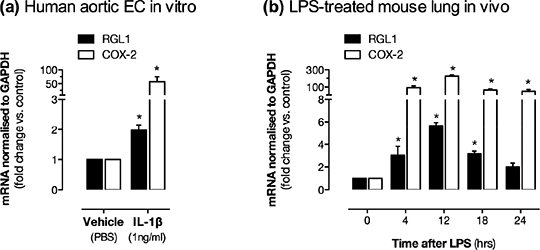Co-induction of the novel gene RGL1 and COX-2 in human endothelial cells in vitro and in mice in vivo Inhibition of cyclo-oxygenase (COX)-2 by non-steroidal anti-inflammatory drugs (NSAIDs) is associated with cardiovascular side effects. The prevailing view was that COX-2 mediates release of the cardio-protective hormone, prostacyclin, from blood vessels and that this explains the cardiovascular toxicity associated with NSAID usage. However, we have shown that in healthy (Kirkby et al., 2012a) as well as atherosclerotic (Kirkby, 2012b) vessels it is COX-1 and not COX-2 that drives vascular prostacyclin. Now, with no clear explanations of where COX-2 is and how it mediates cardio-protection we are taking a systems based approach to identify new leads (Kirkby et al., 2013). We performed a transcriptomic analysis of tissue from COX-2-deficient mice and found that the most altered gene was ral guanine nucleotide dissociation stimulator-like 1 (RGL1), which was reduced. Very little is known about RGL1. Our observations now require validation at several levels in order to interpret any functional associations between COX-2 and RGL1. COX-2 is an inducible gene in infection, inflammation and cancer. Thus, in vivo, COX-2 is induced by LPS and in cells COX-2 is induced by IL-1β. The purpose of the current study was to establish if RGL1 is, like COX-2, an inducible gene in human cells in vitro and in mice in vivo. Human aortic endothelial cells (ECs) were cultured in 12 well plastic plates as described previously (Kirkby et al., 2012a) and treated with IL-1β (1ng/ml) for 24hours. RNA was extracted and expression levels of COX-2, RGL1 or the housekeeping gene GAPDH, measured using qRT-PCR with TaqMan hydrolysis probes. C57Bl/6 mice (male, 12 week old) were treated with LPS (in saline; 10mg/kg; i.p.) for 4-24 hours before being killed by CO2 narcosis. Lungs were removed and RNA extracted. COX2 and RGL1 expression were measured as above and compared to the housekeeping gene 18S. Figure 1: RGL1 and COX-2 in ECs (a) or in mouse lung (b). Data is mean± S.E.M. for n=4 (a) or n=5 (b); *p,0.05 vs. control by (a) Student’ s unpaired t-test or (b) one-way ANOVA and Dunnett’ s post test. These data are the first to show that RGL1 is an inducible gene. Our findings that it is co-induced with COX-2 are in line with these two genes operating under similar conditions. The relationship between COX-2 and RGL1 in inflammation and in the cardiovascular system remains the subject of investigation. Kirkby NS, Lundberg MH, et al., (2012a). Proc Natl Acad Sci U S A 109(43): 17597-17602. Kirkby NS (2012b), PA2online Winter BPS meeting. Kirkby NS, Zaiss AK, Urquhart P, Jiao J, Austin PJ, Al-Yamani M, et al. (2013). PLoS One 8(7): e69524.
|


